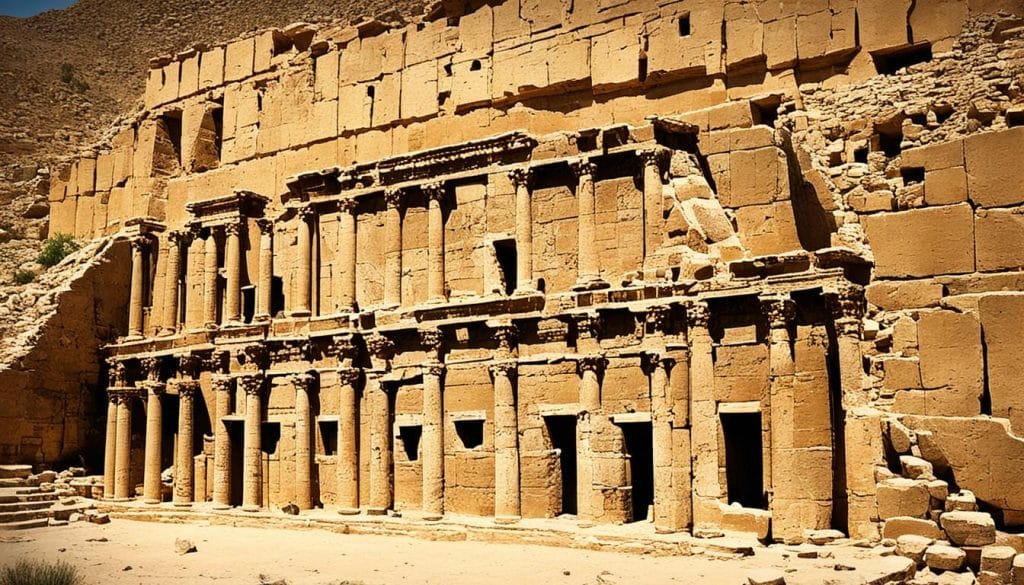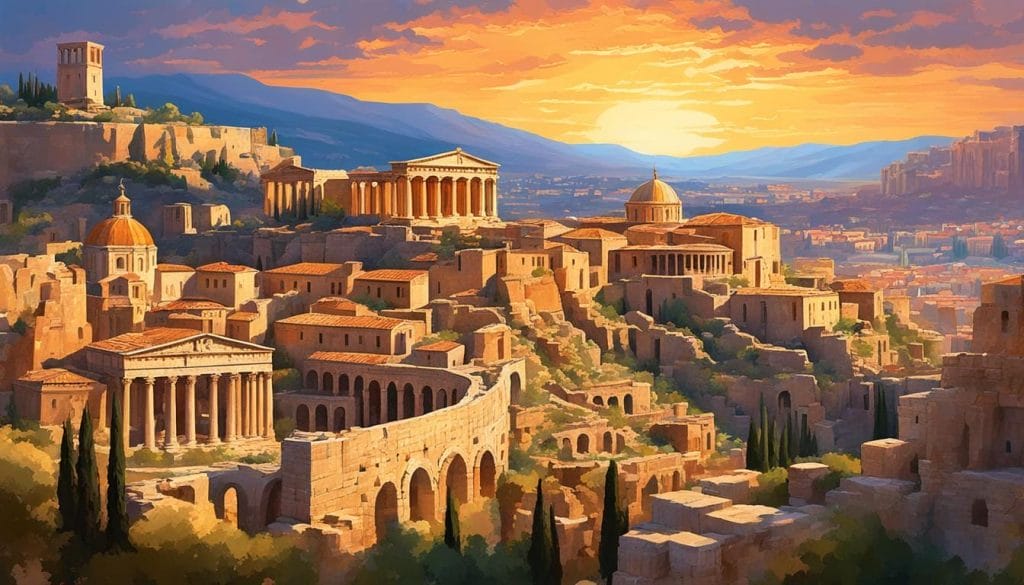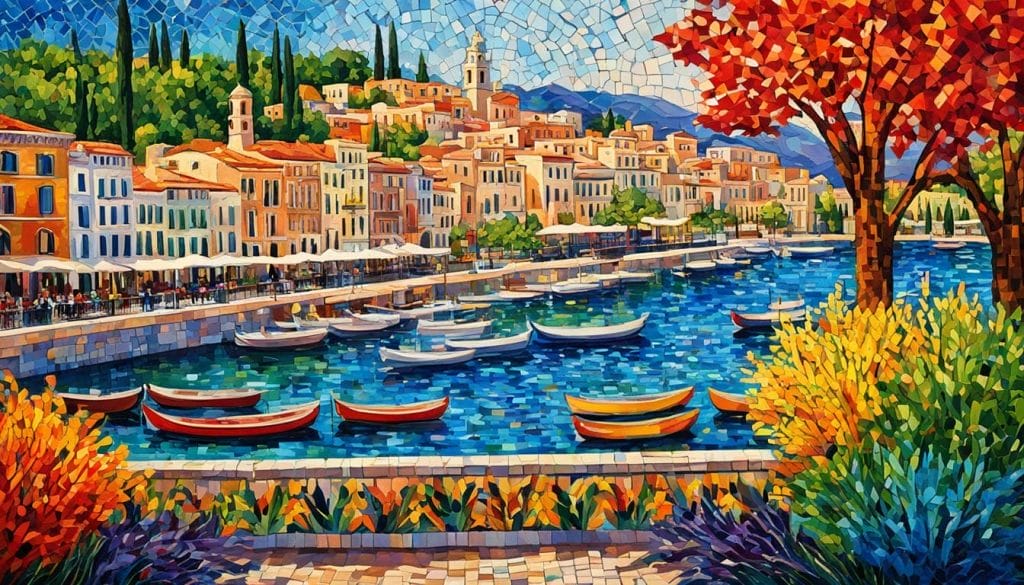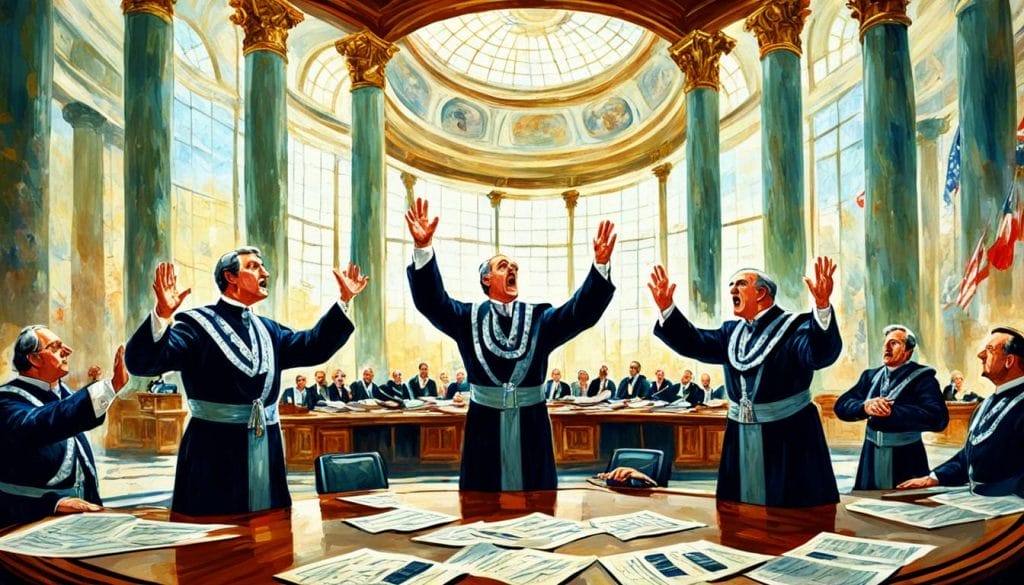Imagine a time when the echoes of orators filled the amphitheaters, and the scent of olives and myrrh perfumed the air of bustling marketplaces. This is no mere artifact of imagination but a glimpse into the Decapolis—a remarkable ensemble of ancient cities that once thrived under Greco-Roman influence. What’s striking is that these ten cities, which boasted remarkable historical landmarks, were not just dots on a map but a complex web of urban jewels adorned with architectural marvels, each contributing a unique thread to the rich tapestry of Middle Eastern history and Greco-Roman culture.
The Decapolis still captures the minds of historians and travelers alike, beckoning with the allure of its temples and colonnades that whisper tales of bygone eras. Its grandeur may have faded with the sands of time, but the legacy of these cities continues to offer invaluable insights into a civilization where Eastern and Western worlds converged in stunning harmony.
Key Takeaways
- “Decapolis” signifies a historical network of ten city-states epitomizing the fusion of Hellenistic and Roman legacies.
- The cities stood as bastions of autonomy, prosperity, and cultural blending amid the overarching narratives of Middle Eastern history.
- Monumental public buildings in the Decapolis bear witness to their economic success and the prevailing peace under Roman rule.
- The architectural landscapes of these ancient cities reflect a sophisticated blend of Greco-Roman artistry and local heritage.
- Decapolis offers a testament to the architectural and political prowess that characterized the Hellenistic period and early Roman dominance.
- Understanding Decapolis is vital for appreciating the broader historical canvas that showcases the enduring impact of Greco-Roman culture.
The Historical Significance of City Leagues
The landscape of the ancient Greek world was uniquely shaped by the establishment of city leagues—foundational regional alliances that solidified relationships between Greek city-states. These leagues were more than mere military pacts; they were the threads of cultural and political kinship that wove together a rich tapestry of Hellenistic society. It was within this context that the Delian League emerged, underpinning a celebrated era of mutual protection and shared identity.
Cultural and Military Alliances in the Greek World
The notion of unity amid divergence became the hallmark of Greek city-states as they navigated the tumultuous Hellenistic period. Enhanced by joint military endeavors, these alliances were anchored more deeply through shared cultural pursuits and religious festivities. Prominent among such alliances was the Delian League—synonymous with the united strength of Athens and its allies against common foes.
Decapolis as a Model for Regional Union
Similarly, in the spirit of these enduring partnerships, the Decapolis stood as a paradigm of regional union, though not in the formalized sense of a league. The adjacent territories, from the majestic Dion to the resplendent Philadelphia, reinforced each other through trade networks, mutual defense strategies, and a cohesive cultural allegiance. Thus, Decapolis was the embodiment of solidarity, showcasing how city-states could thrive together while celebrating their individuality within the Hellenistic world.
Uncovering the Mystery of the Decapolis’s Inhabitants
The intertwined histories and cultures of the Decapolis region have long intrigued historians and archaeologists alike. The mosaic of peoples that populated the cities is often veiled in mystery due to the Hellenization of their names and customs. However, beneath this Greco-Roman veneer, ancient inscriptions and historical accounts suggest a population predominantly of Semitic origin. Among the traces of these Semitic peoples were the influential Nabataeans, merchants, and artisans who left their mark throughout the Middle East.

While direct evidence remains sporadic, the linguistic and epigraphic data suggest a distinctive ethnic diversity in the region. Here, ancient inscriptions are not just carvings on walls or stones; they are the voices from the past, providing invaluable insight into the identities and languages of those who populated the Decapolis.
- Inscriptions bearing the unmistakable angular script characteristic of the Nabataeans
- Evidence of Aramaic-speaking communities, betrayed by their telltale Semitic syntax
- Artifacts suggesting a perpetual exchange between Greek, Roman, and local Nabataean cultures
The adoption of Greek nomenclature made it challenging to discern the precise ethnic composition of the region, but it did not eradicate the rich tapestry woven by various heritages and traditions. Rather, it points to a complex milieu where cultures did not merely coexist but were intricately interwoven to form a vibrant communal narrative, much like the textiles the Nabataeans once traded on their widespread caravans.
The Decapolis, then, serves as a testament to the interactions of diverse groups, absorbing and reinterpreting external influences while preserving a core of Semitic traits. It represents a past that was not dominated by a singular narrative but enriched by the multitude of voices and stories that emanated from its colorful streets and bustling markets.
Architecture and City Planning in the Decapolis
The intricate tapestry of Hellenistic architecture and Roman influence is knitted into the very fabric of Decapolis, where urban design and the construction of public buildings reveal a civilization striving for both splendor and functionality. The legacy of these ancient cityscapes lies in their ability to harmonize Eastern traditions with Western advancements, crafting an environment rich in cultural complexity and architectural innovation.
The Eclectic Fusion of East and West
The hallmark of Decapolis architecture lies in its ability to integrate the meticulous craftsmanship of the Hellenistic period with the grandeur of Roman structures. The cities brimmed with bustling agoras and expansive streets lined with stately columns, representing the pinnacles of ancient urban design. Each city uniquely interpreted the fusion of styles but adhered to a common architectural language that was distinctly Decapolitan.
Monumentalization as a Symbol of Wealth and Power
The opulence of Decapolis is etched in its massive constructions, designed not just for utility but to showcase the city’s unrivaled affluence. Triumphal arches and grandiose temples stood as testaments to the wealth that flowed through these hubs—monoliths of prosperity immortalizing the grand narrative of the Decapolitans.
| City | Notable Public Building | Architectural Features |
|---|---|---|
| Gadara | Theatre | Grand staircase, orchestra, cavea seating |
| Beth-Shean (Scythopolis) | Circus | Oval shape, spina, carceres (starting gates) |
| Gerasa | Triumphal Arch | Barrel vault, composite columns, intricate friezes |
| Pella | Bathhouse | Tepidarium, caldarium, hypocaust system |
| Dion | Temple of Zeus | Corinthian capitals, hexastyle portico, podium |
In this architectural renaissance, the Decapolis cities not only erected structures for the present but also laid the foundations for a legacy that would captivate the imagination of generations to come.
Decapolis: A Reflection of the Pax Romana
The span of the Pax Romana was indeed a transformative era, echoing loudly through the annals of time. Those living within the Decapolis benefitted from a robust period of economic prosperity under the umbrella of Roman peace, an effect seen in the formidable and striking architectural feats of the period. Public investment in monumental construction not only served practical functions but also stood as a symbol of the societal wealth and sophistication emerging from plentiful cultural exchange.

The Economic Boom Under Roman Peace
The security and stability provided by Roman peace fostered the ideal environment for commerce to flourish across borders. Merchants, artisans, and scholars moved freely, sharing goods, ideas, and customs. This interaction became the bedrock for sustained economic prosperity, enabling the Decapolis to invest extravagantly in public amenities and infrastructure, showcasing the wealth and progress of its city-states.
Architectural Testimony to Prosperity and Progress
Remains of ancient grandeur display a narrative of ambition matched with capability, where extensive public investment fed the burgeoning desires of the cities to outdo one another aesthetically. From temples reaching for the heavens to theaters and forums bustling with life, each structure contributed to a legacy of cultural richness and affluence.
| Monumental Site | City | Purpose/Symbolism | Reflection of Pax Romana Influence |
|---|---|---|---|
| Grand Temple of Artemis | Gerasa | Civic Worship and Community | Exemplifies peace-induced religious and cultural diversity |
| The Oval Plaza | Gerasa | Social and Political Gatherings | Public space investment signifying organized societal structure |
| Hippodrome | Scythopolis | Entertainment and Leisure | Shows prosperity enabling large-scale recreational construction |
| Colonnaded Streets | Various Cities | Trade and Commerce | Infrastructure laying the groundwork for economic expansion and cultural interactions |
In sum, the cities of the Decapolis serve not only as a testament to past glories but as evidence of the profound impact stability and cooperation can have on advancing civilization. The cooperative spirit, underlined by a longing for growth and enrichment, was a hallmark of the Pax Romana—an epoch that exhibits, even now, the benefits of cultural openness and strategic public investment.
The Geographic Spread of Decapolis
The Decapolis, a notable historical ensemble of Near Eastern cities, was a testament to the remarkable city-state networks of ancient geography. These city-states were strategically positioned, contributing to a complex web of urban centers with Scythopolis (Beth-Shean) uniquely situated to the west of the Jordan River. Below, we explore the geographic distribution of these cities that defined the area.
Each city within the Decapolis contributed to a collective identity, emphasizing their cultural and economic connections against a backdrop of shifting territorial domains. Not only were these cities central to the expansion of Hellenistic influence in the region, but they also communicated and cooperated with each other, fabricating a powerful network beyond their individual capabilities.
| City | Geographic Location | Notable Features |
|---|---|---|
| Dion | North | Hellenistic Fortifications |
| Philadelphia | South | Roman temples and theatres |
| Scythopolis (Beth-Shean) | West of the Jordan River | Extensive archaeological ruins |
| Other Cities | East of Jordan River and desert frontiers | Various Hellenistic and Roman public structures |
These cities together respected and upheld a system that helped preserve their ancient cultural heritage while under Roman authority. Their geographic distribution along and beyond the Jordan River directly influenced the survival and prosperity of their city-state networks.
The Cultural Melting Pot of the Decapolis
Within the ancient Levant, the Decapolis was a true epitome of cross-cultural heritage, where an intricate tapestry woven from the threads of multiple ancient civilizations flourished. The profound impact of the Decapolis on cultural acclimatization continues to captivate historians and archaeologists as evidence emerges of the vibrant melding of traditions, beliefs, and artistic motifs. This historical nexus not only bears the indelible marks of Macedonian influence but also radiates the enduring essence of Hellenistic values.

Ideas, Lifestyles, and Architectural Styles Collide
The confluence of Hellenistic ideologies with local customs created a cultural climate in which diverse artistic expressions could emerge. This fusion generated a landscape replete with innovation and diversity, best illustrated by the region’s architectural marvels. The amphitheaters, temples, and public squares of the Decapolis stood as monuments not only to imperial might but also to the symphony of influences from Greeks, Nabataeans, and Near Eastern people.
Influence of Greek and Macedonian Civilization
The overarching Greek and Macedonian legacies played a pivotal role in sculpting the socio-cultural and aesthetic ethos of the Decapolis. Imposing colonnades, intricate friezes, and ornate facades expressed the profound impact of Alexander the Great’s conquests and the resulting spread of Hellenism. Yet these Hellenistic frontiers collided with the earthy palettes and motifs indigenous to the region, thereby generating singular works of art and architecture that have stood the test of time.
This melting pot, symbolizing a period of unprecedented cultural assimilation and exchange, ripened into a defining chapter of ancient history. Reflect below on the striking contrasts across key aspects of the Decapolis’ cultural landscape:
| Cultural Element | Macedonian Influence | Local Influence |
|---|---|---|
| Urban Planning | Grid layouts, grand boulevards | Integrated natural topography |
| Architecture | Imperial designs, Greek temples | Symbiotic elements, local materials |
| Arts | Classical motifs, statues | Folk themes, local crafts |
| Governance | Hellenistic polis structure | Traditional leadership systems |
| Social Customs | Greek language and theater | Local festivals and dress |
Here, we observe the enigmatic fusion characteristic of the region: a Greek-inspired boulevard might lead to a local bazaar; a towering Greek statue could overlook a traditional Nabataean dwelling. It is this very synergy of Macedonian influence and regional prowess that continues to echo through the stones of the Decapolis, bearing witness to a remarkable chapter of human history.
Government and Political Structure in Decapolis Cities
Exploring the nuances of government and political structure in the ancient realm of the Decapolis leads to a fascinating discovery of their sophisticated system of self-governance. These cities, recognized for their resemblance to the esteemed Greek city-states, carved out a notable chapter in history with their commitment to political autonomy and community-driven progress. Residents of each polis took pride in participating in the grand tradition of democracy by selecting members for their municipal councils, which held significant sway over local decisions and policies.
Municipal councils were the linchpin of Decapolis governance, taking on the mantle of both leadership and legislative duties. These assemblies were emblematic of the Decapolis’s dedication to autonomy, as each city maintained its distinct cultural identity despite the overarching influence of Roman governance.
The cherished goal of political self-determination was not merely aspirational but fiercely practical, as cities allocated resources towards public works and services, reinforcing community involvement and the overall welfare of the citizenry.
The political institutions of the Decapolis not only facilitated their administrative independence but also served as bedrocks for the citizens’ involvement in matters of governance. This form of self-regulation is evident in the remnants of their legislative forums and public meeting spaces dotting the archaeological landscape, symbols of a society deeply invested in the civic participation of its people.
The citizens of the Decapolis enjoyed a degree of freedom that was the envy of neighboring regions, managing their own affairs and protecting the essence of their city-state culture amidst a vast empire.
It is through the lens of these political achievements that contemporary city governance can find parallels and lessons, emphasizing the enduring value of civic engagement and regional independence.

In summary, as we examine the depth and complexity of Decapolis cities’ political structures, it becomes apparent that the echoes of their commitment to municipal self-determination still resonate in the very foundations of modern democratic principles and civic organization.
Pliny the Elder’s Account of Decapolis
The first-century writings of Pliny the Elder yield an indispensable gaze into the past, painting a detailed panorama of the Decapolis—its diverse territories, political complexities, and cultural richness. His historical accounts, primarily documented in “Naturalis Historia,” offer an early, curated list that defines the network of Decapolitan cities. As a pivotal source among other antiquity sources, Pliny’s work provides a foundational perspective on how the contours of ancient geopolitical landscapes were drawn and re-drawn over time by the forces of history.
Pliny’s List of Decapolitan Cities
In an attempt to capture the essence of the region, Pliny’s list epitomizes the dynamic nature of Decapolis. Roman documentation does not shrink from acknowledging the fluidity with which the cities under this alliance were regarded, at times encompassing a roster that expanded beyond the ten most commonly cited municipalities. This underscored the reality that alliances and identities in ancient times were not static but were instead subject to the vicissitudes of cultural shifts and political maneuvers.
The Varied Definitions of Decapolis Throughout History
The entity known as Decapolis is refracted through the prism of need and circumstance, as conceived by different historical voices, from the comprehensive writings of Josephus to the biblical narratives of the New Testament. These myriad portrayals endow the Decapolis with a multifaceted definition forged over centuries by ever-evolving socio-political events. By retracing these ancient paths through Pliny’s insights and other historical sources, we acquire a broader understanding of the complexity and fluidity that marked regional affiliations in the tapestry of our shared human past.
FAQ
What defines the ancient cities of Decapolis?
The Decapolis refers to a group of cities that were connected by their Hellenistic culture and political ties during the Hellenistic and Roman periods. These cities are known for their public buildings, Hellenistic architecture, and the regional alliances they formed, such as the one that could be likened to the Greek city-states or the Delian League.
How did city leagues influence the structure of Decapolis?
City leagues, such as those in the Greek world, formed cultural and military alliances protecting their interests. The Decapolis shared similar collaborative efforts, though not officially a league, and worked together regionally much like other Hellenistic period alliances.
Who lived in the Decapolis?
The Decapolis was primarily inhabited by people of Semitic origin. The widespread usage of Greek names amongst the population contributes to the enigma surrounding their precise ethnic diversity. It is thought that many inhabitants, including possible descendants of Nabataeans, contributed to the region’s culture.
What are some characteristics of architecture and city planning in the Decapolis?
The Decapolis showcased a remarkable blend of Hellenistic and Roman architectural styles with local elements. Its urban design featured agoras, forums, colonnaded streets, public buildings, theaters, and bathhouses, reflecting wealth and the eclectic fusion of influences from the East and West.
How did Pax Romana influence the Decapolis?
Pax Romana created an era of economic prosperity and cultural exchange that was reflected in the Decapolis through the region’s architectural expansion and progress. The peace and stability of this period allowed for significant public investment in grand temples and civic buildings.
Where was the Decapolis located geographically?
The Decapolis was geographically spread primarily to the east of the Jordan River and included regions from Dion to Philadelphia, encompassing a strategic network of Near Eastern cities with distinct connections to Greek and Macedonian civilizations.
What role did cultural exchange play in the Decapolis?
The Decapolis was a melting pot where cultural elements from Jewish, Greek, Macedonian, Nabataean, and Syrio-Phoenician influences merged. This exchange led to diverse, artistic expressions and innovative architectural styles that marked the region.
What was the political structure like in the cities of the Decapolis?
Cities within the Decapolis operated as independent poleis with self-governance. They had municipal councils and a democratic system akin to those of the ancient Greek city-states, which enabled a certain degree of political autonomy under the overarching Roman control.
How did Pliny the Elder describe the Decapolis?
Pliny the Elder provided one of the earliest accounts of Decapolis, listing cities that were part of this group and noting the fluctuating number which could extend to up to 14 cities. His documentation offers insights into the variable definitions and perceptions of Decapolis throughout antiquity.
Source Links
- https://www.britannica.com/place/Decapolis-ancient-cities-Palestine
- https://www.dighippos.com/decapolis
- https://www.licensestorehouse.com/galleries/decapolis
